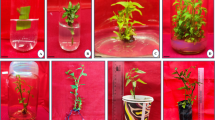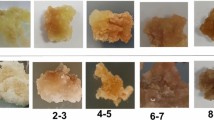Abstract
In vitro breeding and somaclonal variation were used as tools to improve the potential of Indian mustard (Brassica juncea L.) to extract and accumulate toxic metals. Calli from B. juncea were cultivated on a modified MS medium supplemented with 10–200 μM Cd or Pb. Afterwards, new B. juncea somaclones were regenerated from metal-tolerant callus cells. Three different phenotypes with improved tolerance of Cd, Zn and Pb were observed under hydroponic conditions: enhanced metal accumulation in both shoots and roots; limited metal translocation from roots to shoots; reduced accumulation in shoots and roots. Seven out of thirty individual variants showed a significantly higher metal extraction than the control plants. The improvement of metal shoot accumulation of the best regenerant (3× Cd, 1.6× Zn, 1.8× Pb) and metal extraction (6.2× Cd, 3.2× Zn, 3.8× Pb) indicated a successful breeding and selection of B. juncea, which could be used for phytoremediation purpose.




Similar content being viewed by others
Abbreviations
- BAP:
-
6-Benzylaminopurine
- EDTA:
-
Ethylenediaminetetraacetic acid
- GA3 :
-
Gibberellic acid
- MS:
-
Murashige and Skoog medium
- NAA:
-
1-Naphthaleneacetic acid
References
Alibert G, Aslane-Chanabé C, Burrus M (1994) Sunflower tissue and cell cultures and their use in biotechnology. Plant Physiol Biochem 32:31–44
Baker A, Brooks R (1989) Terrestrial higher plants which hyperaccumulate heavy elements: a review of their distribution, ecology and phytochemistry. Biorecovery 1:81–126
Chaney R (1983) Plant uptake of inorganic waste constituents. In: Parr P, Marsh P, Kla J (eds) Land treatment of hazardous wastes. Noyes Data, Park Ridge, NJ, pp 50–76
Clemens S, Palmgren MG, Krämer U (2002) A long way ahead: understanding and engineering plant metal accumulation. Trends Plant Sci 7:309–315
Fazekas GA, Sedmach PA, Palmer MV (1986) Genetic and environmental effects on in vitro shoot regeneration from cotyledon explants of Brassica juncea. Plant Cell Tiss Org 6:177–180
George L, Rao PS (1980) In vitro regeneration of mustard plants (Brassica juncea var. Rai-5) of cotyledon explants from non-irradiated, irradiated and mutagen treated seeds. Ann Bot 46:107–112
George EF, Sherrington PD (1984) Progress in micropropagation. In: George EF, Sherrington PD (eds) Plant propagation by tissue culture. Handbook and directory of commercial laboratories. Eversley, Basingstoke, Hants. RG27 OQY, England, chapter 9, pp 519–524
George L, Abraham V, Suryavanshi DR, Sipahimalani AT, Srinivasan VT (1987) Yield, oil content and fatty acid composition evaluated in androgenetic plants in Brassica juncea. Plant Breed 98:72–74
Greger M (2004) Metal availability, uptake, transport and accumulation in plants. In: Prasad MNV (ed) Heavy metal stress in plants from biomolecules to ecosystem. Springer-Verlag, Berlin Heidelberg, pp 1–27
Grotz N, Fox TC, Connoly E, Park W, Guerinot ML, Eide D (1998) Identification of a family of zinc transporter genes from Arabidopsis that respond to zinc deficiency. Proc Natl Acad Sci USA 95:7220–7224
Guadagnini M (2000) In vitro-breeding for metal accumulation in two tobacco (Nicotiana tabacum) cultivars. Thesis no. 1288, University Freiburg, Switzerland, p 99
Guadagnini M, Herzig R, Erismann KH, Müller-Schärer H (1999) In vitro Züchtung, Selektion und Erprobung von metal-akkumulierenden Tabakvarianten zur Bodensanierung. TerraTech 6:52–54
Guerinot ML (2000) The ZIP family of metal transporters. Biochim Biophys Acta 1465:190–198
Guo Y, Marschner H (1996) Genotypic differencing in uptake and translocation of cadmium in bean and maize inbred lines. Z Pflanzenernähr Bodenk 159:55–60
Herzig R, Guadagnini M, Erisman KH, Müller-Schärer H (1997) Chancen der Phytoextraktion. Sanfte Bodendekontamination von Schwermetallen mit Hilfe biotechnisch verbesserter Akkumulatorpflanzen. TerraTech 2:49–52
Herzig R, Guadagnini M, Rehnert A, Erismann KH (2003) Phytoextraction efficiency of in vitro-bred tobacco variants using a non-GMO approach. In: Vanek T, Schwitzguébel JP (eds) Phytoremediation Inventory – COST Action 837 View. Prague, UOCHB AVCR, ISBN 80–86241–19-X, p 73
Huang JW, Cunningham SD (1996) Lead phytoextraction: species variation in lead uptake and translocation. New Phytol 145:75–84
Huang B, Hatch E, Goldsbrought PB (1987) Selection and characterization of cadmium tolerant cell in tomato. Plant Sci 52:211–221
Jackson PJ, Roth EJ, McClure PT, Naranjo CM (1984) Selection, isolation and characterization of cadmium resistance Datura innoxia suspension cultures. Plant Physiol 75:914–918
Jain RK, Sharma DR, Chowdhury JB (1989) High frequency regeneration and heritable somaclonal variation in Brassica juncea. Euphytica 40:75–81
Jain RK, Jain S, Nainawatee HS, Chowdhury JB (1990) Salt tolerance in Brassica juncea L. 1. In vitro selection, agronomic evaluation and genetic stability. Euphytica 48:141–152
Jan VV, Demacedo CC, Kinet JM, Bouharmont J (1997) Selection of Al-resistant plants from a sensitive rice cultivar using somaclonal variation, in vitro and hydroponic cultures. Euphytica 97:303–310
Katiyar RK, Chopra VL (1995) A somaclone of Brassica juncea is processed into a variety and is released for commercial cultivation in India. Cruciferae Newslett 17:92–93
Kirti PB, Hadi S, Kuma PA, Chopra VL (1991) Production of sodium chloride tolerant Brassica juncea plants by in vitro selection at the somatic embryo level. Theor Appl Genet 83:233–237
Krämer U, Cotter-Howells JD, Charnorck JM, Baker AJM, Smith JA (1996) Free histidine as a metal chelator in plants that accumulate nickel. Nature 379:635–638
Kumar PBAN, Dushenkov V, Motto H, Raskin I (1995) Phytoextraction—the use of plants to remove heavy metals from soils. Environ Sci Technol 29:1232–1238
Mench M, Tancogne J, Gornez A, Juste C (1989) Cadmium bioavailability to Nicotiana tabacum L., Nicotiana rustica L., and Zea mays L. grown in soil amended or not amended with cadmium nitrate. Biol Fertil Soil 8:48–53
Moon DH, Ottoboni LML, Souza AP, Sibov ST, Gasper M, Arruda P (1997) Somaclonal variation induced aluminium sensitive mutant from an aluminium inbred maize tolerant line. Plant Cell Rep 16:686–691
Murashige T, Skoog F (1962) A revised medium for growth and rapid bioassays with tobacco culture. Physiol Plant 15:473–497
Nehnevajova E, Benova A, Kakoniova D, Lux A, Liskova D (2002) Effect of cadmium on the growth of Ginkgo biloba L. callus cultures. In: Book of abstract: ecophysiology of plant stress, Proceedings of the 5th international conference, Nitra, Slovakia, 3–4 July
Nehnevajova E, Herzig R, Federer G, Erismann KH, Schwitzguébel JP (2005) Screening of sunflower cultivars for metal phytoextraction in a contaminated field prior to mutagenesis. Int J Phytorem 7:337–349
Nehnevajova E, Herzig R, Federer G, Erismann KH, Schwitzguébel, JP (2006) Chemical mutagenesis—an efficient technique to enhance metal accumulation and extraction in sunflowers. Int J Phytorem (in press)
Ramgareeb S, Watt MP, Marsh C, Cooke JA (1999) Assessment of Al3+ availability in callus culture media for screening tolerant genotypes of Cynodon dactylon. Plant Cell Tiss Org 56:65–68
Reeves RD, Baker AJM (2000) Metal-accumulating plants. In: Raskin I, Ensley BD (eds) Phytoremediation of toxic metals—using plants to clean up the environment. Wiley, New York, pp 193–229
Rout GR, Samantary S, Das P (1998) In vitro selection and characterization of Ni-tolerant callus lines of Stelaria italica L. Acta Physiol Plant 20:269–275
Rout GR, Samantary S, Das P (1999) In vitro selection and biochemical characterization of zinc and manganese adapted callus in Brassica spp. Plant Sci 146:89–100
Salt DE, Smith RD, Raskin I (1998) Phytoremediation. Annu Rev Plant Phys 49:643–668
Seliskar DM, Gallagher JL (2000) Exploiting wild population diversity and somaclonal variation in the salt marsh grass Distichlis spicata (Poaceae) for marsh creation and restoration. Am J Bot 87:141–146
Sibov ST, Gasper M, Silva MJ, Ottoboni LMM, Arruda P, Souza AP (1999) Two genes control aluminium tolerance in maize: genetic and molecular mapping analyses. Genome 42:475–482
Skirvin RM, Norton M, McPheeters KD (1993) Somaclonal variation: has it proved useful for plant improvement? Acta Hort 336:333–340
Tang GX, Zhou WJ, Li HZ, Mao BZ, He ZH, Yoneyama K (2003) Medium, explant and genotype factors influencing shoot regeneration in oilseed Brassica sp. J Agronom Crop Sci 189:351–358
Vassilev A, Schwitzguébel JP, Thewys T, Van Der Lelie D, Vangronsveld J (2004) The use of plants for remediation of metal contaminated soils. Sci World J 4:9–34
Wollgiehn R, Neumann D (1999) Metal stress response and tolerance of cultured cells from Silene vulgaris and Lycopersicon peruvianum: role of heat stress proteins. J Plant Physiol 154:547–553
Acknowledgements
We thank Dr. Garry Banuelos from USDA Fresno, CA, USA, who kindly provided the seeds of Brassica juncea L. This work was part of the EU-Framework Programme Quality of Life and Managing of Living Organisms (QLRT-2001-00429): PHYTAC-Development of systems to improve phytoremediation of metal contaminated soils through improved phytoaccumulation and was financed by the Swiss Federal Office for Education and Science.
Author information
Authors and Affiliations
Corresponding author
Additional information
Communicated by M. C. Jordan
Rights and permissions
About this article
Cite this article
Nehnevajova, E., Herzig, R., Erismann, KH. et al. In vitro breeding of Brassica juncea L. to enhance metal accumulation and extraction properties. Plant Cell Rep 26, 429–437 (2007). https://doi.org/10.1007/s00299-006-0264-9
Received:
Revised:
Accepted:
Published:
Issue Date:
DOI: https://doi.org/10.1007/s00299-006-0264-9




